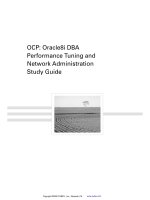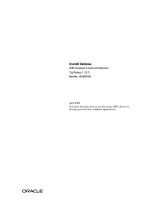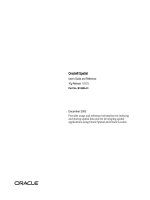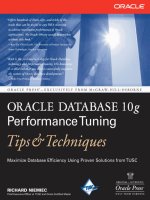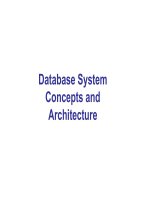oracle 9-2 database performance tuning and reference
Bạn đang xem bản rút gọn của tài liệu. Xem và tải ngay bản đầy đủ của tài liệu tại đây (6.42 MB, 818 trang )
Oracle9i
Database Performance Tuning Guide and Reference
Release 2 (9.2)
March 2002
Part No. A96533-01
Oracle9i Database Performance Tuning Guide and Reference, Release 2 (9.2)
Part No. A96533-01
Copyright © 2001, 2002 Oracle Corporation. All rights reserved.
Primary Author: Lenore Luscher
Contributing Author: Connie Dialeris Green
Graphic Designer: Valarie Moore
Contributors: James Barlow, Qiang Cao, Sumanta Chatterjee, Benoit Dageville, Vinayagam
Djegaradjane, Harvey Eneman, Bjorn Engsig, Cecilia Gervasio, Leslie Gloyd, Lester Gutierrez, Karl Haas,
Brian Hirano, Andrew Holdsworth, Mamdouh Ibrahim, Christopher Jones, Srinivas Kareenhalli, Stella
Kister, Herve Lejeune, Yunrui Li, Juan Loaiza, George Lumpkin, Joe McDonald, Bill McKenna, Sujatha
Muthulingam, Gary Ngai, Michael Orlowski, Richard Powell, Shankar Raman, Vinay Srihari, Sankar
Subramanian, Margaret Susairaj, Hal Takahara, Nitin Vengurlekar, Stephen Vivian, Simon Watt, Andrew
Witkowski, Graham Wood, and Mohamed Zait.
The Programs (which include both the software and documentation) contain proprietary information of
Oracle Corporation; they are provided under a license agreement containing restrictions on use and
disclosure and are also protected by copyright, patent and other intellectual and industrial property
laws. Reverse engineering, disassembly or decompilation of the Programs, except to the extent required
to obtain interoperability with other independently created software or as specified by law, is prohibited.
The information contained in this document is subject to change without notice. If you find any problems
in the documentation, please report them to us in writing. Oracle Corporation does not warrant that this
document is error-free. Except as may be expressly permitted in your license agreement for these
Programs, no part of these Programs may be reproduced or transmitted in any form or by any means,
electronic or mechanical, for any purpose, without the express written permission of Oracle Corporation.
If the Programs are delivered to the U.S. Government or anyone licensing or using the programs on
behalf of the U.S. Government, the following notice is applicable:
Restricted Rights Notice Programs delivered subject to the DOD FAR Supplement are "commercial
computer software" and use, duplication, and disclosure of the Programs, including documentation,
shall be subject to the licensing restrictions set forth in the applicable Oracle license agreement.
Otherwise, Programs delivered subject to the Federal Acquisition Regulations are "restricted computer
software" and use, duplication, and disclosure of the Programs shall be subject to the restrictions in FAR
52.227-19, Commercial Computer Software - Restricted Rights (June, 1987). Oracle Corporation, 500
Oracle Parkway, Redwood City, CA 94065.
The Programs are not intended for use in any nuclear, aviation, mass transit, medical, or other inherently
dangerous applications. It shall be the licensee's responsibility to take all appropriate fail-safe, backup,
redundancy, and other measures to ensure the safe use of such applications if the Programs are used for
such purposes, and Oracle Corporation disclaims liability for any damages caused by such use of the
Programs.
Oracle is a registered trademark, and Oracle Expert, Oracle Store, Oracle7, Oracle8, Oracle9i,PL/SQL,
SQL*Net, SQL*Plus, and iSQL*Plus are trademarks or registered trademarks of Oracle Corporation.
Other names may be trademarks of their respective owners.
iii
Contents
Send Us Your Comments xix
Preface xxi
Audience xxii
Organization xxii
Related Documentation xxvi
Conventions xxvii
Documentation Accessibility xxix
What’s New in Oracle Performance? xxxi
Part I Writing and Tuning SQL
1 Introduction to the Optimizer
Overview of SQL Processing Architecture 1-2
Overview of the Optimizer 1-3
Steps in Optimizer Operations 1-4
Understanding Execution Plans 1-5
Choosing an Optimizer Approach and Goal 1-10
How the CBO Optimizes SQL Statements for Fast Response 1-14
Features that Require the CBO 1-15
Understanding the CBO 1-16
Architecture of the CBO 1-17
Understanding Access Paths for the CBO 1-24
iv
Full Table Scans 1-25
Sample Table Scans 1-29
Rowid Scans 1-29
Index Scans 1-30
Cluster Scans 1-41
Hash Scans 1-41
How the CBO Chooses an Access Path 1-41
Understanding Joins 1-44
How the CBO Executes Join Statements 1-44
How the CBO Chooses the Join Method 1-45
Nested Loop Joins 1-46
Nested Loop Outer Joins 1-50
Hash Joins 1-51
Hash Join Outer Joins 1-54
Sort Merge Joins 1-56
Sort Merge Outer Joins 1-59
Cartesian Joins 1-60
Full Outer Joins 1-65
How the CBO Chooses Execution Plans for Joins 1-66
How the CBO Executes Antijoins 1-67
How the CBO Executes Semijoins 1-67
How the CBO Executes Star Queries 1-68
Setting Cost-Based Optimizer Parameters 1-68
Enabling CBO Features 1-69
Controlling the Behavior of the CBO 1-71
Overview of the Extensible Optimizer 1-74
Understanding User-Defined Statistics 1-75
Understanding User-Defined Selectivity 1-76
Understanding User-Defined Costs 1-76
2 Optimizer Operations
How the Optimizer Performs Operations 2-2
How the CBO Evaluates IN-List Iterators 2-3
How the CBO Evaluates Concatenation 2-6
How the CBO Evaluates Remote Operations 2-10
v
How the CBO Executes Distributed Statements 2-13
How the CBO Executes Sort Operations 2-14
How the CBO Executes Views 2-18
How the CBO Evaluates Constants 2-19
How the CBO Evaluates the UNION and UNION ALL Operators 2-20
How the CBO Evaluates the LIKE Operator 2-22
How the CBO Evaluates the IN Operator 2-22
How the CBO Evaluates the ANY or SOME Operator 2-22
How the CBO Evaluates the ALL Operator 2-23
How the CBO Evaluates the BETWEEN Operator 2-24
How the CBO Evaluates the NOT Operator 2-24
How the CBO Evaluates Transitivity 2-25
How the CBO Optimizes Common Subexpressions 2-26
How the CBO Evaluates DETERMINISTIC Functions 2-29
How the Optimizer Transforms SQL Statements 2-30
How the CBO Transforms ORs into Compound Queries 2-30
How the CBO Unnests Subqueries 2-34
How the CBO Merges Views 2-36
How the CBO Pushes Predicates 2-39
How the CBO Executes Compound Queries 2-49
3 Gathering Optimizer Statistics
Understanding Statistics 3-2
Generating Statistics 3-3
Using the DBMS_STATS Package 3-5
Using the ANALYZE Statement 3-13
Finding Data Distribution 3-13
Missing Statistics 3-13
Using Statistics 3-14
Managing Statistics 3-14
Verifying Table Statistics 3-16
Verifying Index Statistics 3-17
Verifying Column Statistics 3-18
Using Histograms 3-20
When to Use Histograms 3-21
vi
Creating Histograms 3-21
Types of Histograms 3-22
Viewing Histograms 3-24
Verifying Histogram Statistics 3-24
4 Understanding Indexes and Clusters
Understanding Indexes 4-2
Tuning the Logical Structure 4-2
Choosing Columns and Expressions to Index 4-3
Choosing Composite Indexes 4-4
Writing Statements That Use Indexes 4-6
Writing Statements That Avoid Using Indexes 4-6
Re-creating Indexes 4-7
Compacting Indexes 4-7
Using Nonunique Indexes to Enforce Uniqueness 4-8
Using Enabled Novalidated Constraints 4-8
Using Function-based Indexes 4-10
Using Index-Organized Tables 4-12
Using Bitmap Indexes 4-12
When to Use Bitmap Indexes 4-12
Using Bitmap Indexes with Good Performance 4-15
Initialization Parameters for Bitmap Indexing 4-17
Using Bitmap Access Plans on Regular B-tree Indexes 4-17
Bitmap Index Restrictions 4-18
Using Bitmap Join Indexes 4-19
Using Domain Indexes 4-19
Using Clusters 4-20
Using Hash Clusters 4-21
5 Optimizer Hints
Understanding Optimizer Hints 5-2
Specifying Hints 5-3
Using Optimizer Hints 5-6
Hints for Optimization Approaches and Goals 5-6
Hints for Access Paths 5-10
vii
Hints for Query Transformations 5-18
Hints for Join Orders 5-23
Hints for Join Operations 5-25
Hints for Parallel Execution 5-29
Additional Hints 5-34
Using Hints with Views 5-42
6 Optimizing SQL Statements
Goals for Tuning 6-2
Reduce the Workload 6-2
Balance the Workload 6-2
Parallelize the Workload 6-3
Identifying and Gathering Data on Resource-Intensive SQL 6-3
Identifying Resource-Intensive SQL 6-3
Gathering Data on the SQL Identified 6-5
Dynamic Sampling 6-6
When to Use Dynamic Sampling 6-6
How to Use Dynamic Sampling to Improve Performance 6-6
Overview of SQL Statement Tuning 6-7
Verifying Optimizer Statistics 6-8
Reviewing the Execution Plan 6-8
Restructuring the SQL Statements 6-9
Controlling the Access Path and Join Order with Hints 6-18
Restructuring the Indexes 6-22
Modifying or Disabling Triggers and Constraints 6-22
Restructuring the Data 6-22
Maintaining Execution Plans Over Time 6-23
Visiting Data as Few Times as Possible 6-23
7 Using Plan Stability
Using Plan Stability to Preserve Execution Plans 7-2
Using Hints with Plan Stability 7-2
Storing Outlines 7-4
Enabling Plan Stability 7-4
Using Supplied Packages to Manage Stored Outlines 7-4
viii
Creating Outlines 7-4
Using and Editing Stored Outlines 7-6
Viewing Outline Data 7-9
Moving Outline Tables 7-9
Using Plan Stability with the Cost-Based Optimizer 7-11
Using Outlines to Move to the Cost-Based Optimizer 7-11
Upgrading and the Cost-Based Optimizer 7-12
8 Using the Rule-Based Optimizer
Overview of the Rule-Based Optimizer (RBO) 8-2
Understanding Access Paths for the RBO 8-2
Choosing Execution Plans for Joins with the RBO 8-15
Transforming and Optimizing Statements with the RBO 8-17
Transforming ORs into Compound Queries with the RBO 8-17
Using Alternative SQL Syntax 8-20
Part II SQL-Related Performance Tools
9 Using EXPLAIN PLAN
Understanding EXPLAIN PLAN 9-2
How Execution Plans Can Change 9-2
Minimizing Throw-Away 9-3
Looking Beyond Execution Plans 9-4
Creating the PLAN_TABLE Output Table 9-4
Running EXPLAIN PLAN 9-5
Identifying Statements for EXPLAIN PLAN 9-5
Specifying Different Tables for EXPLAIN PLAN 9-5
Displaying PLAN_TABLE Output 9-6
Reading EXPLAIN PLAN Output 9-7
Viewing Bitmap Indexes with EXPLAIN PLAN 9-10
Viewing Partitioned Objects with EXPLAIN PLAN 9-11
Examples of Displaying Range and Hash Partitioning with EXPLAIN PLAN 9-12
Examples of Pruning Information with Composite Partitioned Objects 9-14
Examples of Partial Partition-wise Joins 9-16
ix
Examples of Full Partition-wise Joins 9-17
Examples of INLIST ITERATOR and EXPLAIN PLAN 9-18
Example of Domain Indexes and EXPLAIN PLAN 9-19
Viewing Parallel Execution with EXPLAIN PLAN 9-20
CPU Costing Model 9-21
EXPLAIN PLAN Restrictions 9-22
PLAN_TABLE Columns 9-23
10 Using SQL Trace and TKPROF
Understanding SQL Trace and TKPROF 10-2
Understanding the SQL Trace Facility 10-2
Understanding TKPROF 10-3
Using the SQL Trace Facility and TKPROF 10-3
Step 1: Setting Initialization Parameters for Trace File Management 10-4
Step 2: Enabling the SQL Trace Facility 10-6
Step 3: Formatting Trace Files with TKPROF 10-7
Step 4: Interpreting TKPROF Output 10-12
Step 5: Storing SQL Trace Facility Statistics 10-17
Avoiding Pitfalls in TKPROF Interpretation 10-20
Avoiding the Argument Trap 10-20
Avoiding the Read Consistency Trap 10-20
Avoiding the Schema Trap 10-21
Avoiding the Time Trap 10-22
Avoiding the Trigger Trap 10-23
Sample TKPROF Output 10-24
Sample TKPROF Header 10-24
Sample TKPROF Body 10-24
Sample TKPROF Summary 10-31
11 Using Autotrace in SQL*Plus
Controlling the Autotrace Report 11-2
Execution Plan 11-3
Statistics 11-4
Tracing Parallel and Distributed Queries 11-8
SET Variables Influencing SQL*Plus Performance 11-11
x
iSQL*Plus Server Statistics 11-12
Interpreting Active Statistics 11-15
Monitoring Disk Reads and Buffer Gets 11-16
12 Using Oracle Trace
Overview of Oracle Trace 12-2
Event Data 12-2
Event Sets 12-2
Accessing Collected Data 12-3
Collecting Oracle Trace Data 12-3
Using the Oracle Trace Command-Line Interface 12-3
Using Initialization Parameters to Control Oracle Trace 12-7
Controlling Oracle Trace Collections from PL/SQL 12-10
Accessing Oracle Trace Collection Results 12-12
Formatting Oracle Trace Data to Oracle Tables 12-13
Running the Oracle Trace Reporting Utility 12-14
Oracle Server Events 12-15
Data Items Collected for Events 12-16
Items Associated with Each Event 12-22
Troubleshooting Oracle Trace 12-32
Oracle Trace Configuration 12-33
Formatter Tables 12-37
Part III Creating a Database for Good Performance
13 Building a Database for Performance
Initial Database Creation 13-2
Database Creation Using the Installer 13-2
Manual Database Creation 13-2
Parameters Necessary for Initial Database Creation 13-2
The CREATE DATABASE Statement 13-3
Running Data Dictionary Scripts 13-4
Sizing Redo Log Files 13-5
Creating Subsequent Tablespaces 13-6
xi
Creating Tables for Good Performance 13-7
Data Segment Compression 13-8
Loading and Indexing Data 13-10
Using SQL*Loader for Good Performance 13-10
Efficient Index Creation 13-11
Initial Instance Configuration 13-12
Configuring Undo Space 13-14
Setting up Operating System, Database, and Network Monitoring 13-15
14 Memory Configuration and Use
Understanding Memory Allocation Issues 14-2
Oracle Memory Caches 14-2
Dynamically Changing Cache Sizes 14-2
Application Considerations 14-4
Operating System Memory Use 14-4
Iteration During Configuration 14-5
Configuring and Using the Buffer Cache 14-6
Using the Buffer Cache Effectively 14-6
Sizing the Buffer Cache 14-6
Interpreting and Using the Buffer Cache Advisory Statistics 14-11
Considering Multiple Buffer Pools 14-13
Buffer Pool Data in V$DB_CACHE_ADVICE 14-15
Buffer Pool Hit Ratios 14-15
Determining Which Segments Have Many Buffers in the Pool 14-15
KEEP Pool 14-17
RECYCLE Pool 14-18
Configuring and Using the Shared Pool and Large Pool 14-19
Shared Pool Concepts 14-19
Using the Shared Pool Effectively 14-23
Sizing the Shared Pool 14-28
Interpreting Shared Pool Statistics 14-34
Using the Large Pool 14-35
Using CURSOR_SPACE_FOR_TIME 14-39
Caching Session Cursors 14-40
Configuring the Reserved Pool 14-40
xii
Keeping Large Objects to Prevent Aging 14-43
CURSOR_SHARING for Existing Applications 14-44
Configuring and Using the Java Pool 14-46
Configuring and Using the Redo Log Buffer 14-46
Sizing the Log Buffer 14-47
Log Buffer Statistics 14-47
Configuring the PGA Working Memory 14-48
Automatic PGA Memory Management 14-50
Configuring SORT_AREA_SIZE 14-67
15 I/O Configuration and Design
Understanding I/O 15-2
Basic I/O Configuration 15-6
Determining Application I/O Characteristics 15-6
I/O Configuration Decisions 15-10
Know Your I/O System 15-10
Match I/O Requirements with the I/O System 15-11
Lay Out the Files Using Operating System or Hardware Striping 15-12
Manually Distributing I/O 15-16
When to Separate Files 15-17
Three Sample Configurations 15-20
Oracle-Managed Files 15-21
Choosing Data Block Size 15-22
16 Understanding Operating System Resources
Understanding Operating System Performance Issues 16-2
Using Operating System Caches 16-2
Memory Usage 16-4
Using Process Schedulers 16-5
Using Operating System Resource Managers 16-5
Solving Operating System Problems 16-7
Performance Hints on UNIX-Based Systems 16-7
Performance Hints on NT Systems 16-8
Performance Hints on Midrange and Mainframe Computers 16-8
Understanding CPU 16-9
xiii
Context Switching 16-11
Finding System CPU Utilization 16-12
17 Configuring Instance Recovery Performance
Understanding Instance Recovery 17-2
Checkpointing and Cache Recovery 17-2
How Checkpoints Affect Performance 17-3
Reducing Checkpoint Frequency to Optimize Runtime Performance 17-3
Configuring the Duration of Cache Recovery 17-4
Use Fast-Start Checkpointing to Limit Instance Recovery Time 17-4
Set LOG_CHECKPOINT_TIMEOUT to Influence the Amount of Redo 17-6
Set LOG_CHECKPOINT_INTERVAL to Influence the Amount of Redo 17-6
Use Parallel Recovery to Speed up Redo Application 17-7
Initialization Parameters that Influence Cache Recovery Time 17-7
Monitoring Cache Recovery 17-8
MTTR Advisory 17-15
How MTTR Advisory Works 17-15
Enabling MTTR Advisory 17-15
Viewing MTTR Advisory 17-16
Tuning Transaction Recovery 17-17
18 Configuring Undo and Temporary Segments
Configuring Undo Segments 18-2
Configuring Automatic Undo Management 18-2
Configuring Rollback Segments 18-2
Configuring Temporary Tablespaces 18-4
19 Configuring Shared Servers
Configuring the Number of Shared Servers 19-2
Identifying Contention Using the Dispatcher-Specific Views 19-2
Reducing Contention for Dispatcher Processes 19-3
Reducing Contention for Shared Servers 19-5
Determining the Optimal Number of Dispatchers and Shared Servers 19-8
xiv
Part IV System-Related Performance Tools
20 Oracle Tools to Gather Database Statistics
Overview of Tools 20-2
Principles of Data Gathering 20-2
Interpreting Statistics 20-3
Oracle Enterprise Manager Diagnostics Pack 20-5
Statspack 20-6
V$ Performance Views 20-6
21 Using Statspack
Statspack Compared with BSTAT/ESTAT 21-2
How Statspack Works 21-3
Configuring Statspack 21-3
Database Space Requirements for Statspack 21-3
Installing Statspack 21-4
Interactive Statspack Installation 21-4
Batch Mode Statspack Installation 21-5
Using Statspack 21-6
Taking a Statspack Snapshot 21-6
Automating Statistics Gathering 21-8
Running a Statspack Performance Report 21-9
Configuring the Amount of Data Captured in Statspack 21-15
Time Units Used for Wait Events 21-19
Event Timings 21-20
Managing and Sharing Statspack Performance Data 21-21
Oracle Real Application Clusters Considerations with Statspack 21-24
Removing Statspack 21-24
Statspack Supplied Scripts and Documentation 21-25
Scripts for Statspack Installation 21-25
Scripts for Statspack Reporting and Automation 21-25
Scripts for Upgrading Statspack 21-26
Scripts for Statspack Performance Data Maintenance 21-26
Statspack Documentation 21-26
xv
Part V Optimizing Instance Performance
22 Instance Tuning
Performance Tuning Principles 22-2
Baselines 22-2
The Symptoms and the Problems 22-3
When to Tune 22-4
Performance Tuning Steps 22-5
Define the Problem 22-6
Examine the Host System 22-7
Examine the Oracle Statistics 22-10
Implement and Measure Change 22-14
Interpreting Oracle Statistics 22-15
Examine Load 22-15
Using Wait Event Statistics to Drill Down to Bottlenecks 22-16
Table of Wait Events and Potential Causes 22-19
Additional Statistics 22-20
Wait Events 22-24
SQL*Net 22-26
buffer busy waits 22-28
db file scattered read 22-30
db file sequential read 22-32
direct path read and direct path read (lob) 22-34
direct path write 22-36
enqueue 22-37
free buffer waits 22-40
latch free 22-43
log buffer space 22-48
log file switch 22-48
log file sync 22-49
rdbms ipc reply 22-50
Idle Wait Events 22-50
xvi
23 Tuning Networks
Understanding Connection Models 23-2
Detecting Network Problems 23-6
Using Dynamic Performance Views for Network Performance 23-6
Understanding Latency and Bandwidth 23-6
Solving Network Problems 23-8
Finding Network Bottlenecks 23-8
Dissecting Network Bottlenecks 23-10
Using Array Interfaces 23-13
Adjusting Session Data Unit Buffer Size 23-14
Using TCP.NODELAY 23-14
Using Connection Manager 23-14
Part VI Performance-Related Reference Information
24 Dynamic Performance Views for Tuning
Current State Views 24-2
Counter/Accumulator Views 24-2
Information Views 24-4
V$DB_OBJECT_CACHE 24-4
V$FILESTAT 24-6
V$LATCH 24-9
V$LATCH_CHILDREN 24-12
V$LATCHHOLDER 24-13
V$LIBRARYCACHE 24-14
V$LIBRARY_CACHE_MEMORY 24-16
V$LOCK 24-16
V$MTTR_TARGET_ADVICE 24-21
V$MYSTAT 24-21
V$OPEN_CURSOR 24-22
V$PARAMETER and V$SYSTEM_PARAMETER 24-24
V$PROCESS 24-25
V$ROLLSTAT 24-27
V$ROWCACHE 24-28
xvii
V$SEGMENT_STATISTICS 24-30
V$SEGSTAT 24-31
V$SEGSTAT_NAME 24-31
V$SESSION 24-31
V$SESSION_EVENT 24-35
V$SESSION_WAIT 24-36
V$SESSTAT 24-40
V$SHARED_POOL_ADVICE 24-43
V$SQL 24-44
V$SQL_PLAN 24-44
V$SQL_PLAN_STATISTICS 24-50
V$SQL_PLAN_STATISTICS_ALL 24-52
V$SQLAREA 24-56
V$SQLTEXT 24-59
V$STATISTICS_LEVEL 24-60
V$SYSSTAT 24-60
V$SYSTEM_EVENT 24-66
V$UNDOSTAT 24-68
V$WAITSTAT 24-69
A Schemas Used in Performance Examples
Glossary
Index
xviii
xix
Send Us Your Comments
Oracle9i Database Performance Tuning Guide and Reference, Release 2 (9.2)
Part No. A96533-01
Oracle Corporation welcomes your comments and suggestions on the quality and usefulness of this
document. Your input is an important part of the information used for revision.
■ Did you find any errors?
■ Is the information clearly presented?
■ Do you need more information? If so, where?
■ Are the examples correct? Do you need more examples?
■ What features did you like most?
If you find any errors or have any other suggestions for improvement, please indicate the document
title and part number, and the chapter, section, and page number (if available). You can send
commentstousinthefollowingways:
■ Electronic mail:
■ FAX: (650) 506-7227 Attn: Server Technologies Documentation Manager
■ Postal service:
Oracle Corporation
Server Technologies Documentation
500 Oracle Parkway, Mailstop 4op11
Redwood Shores, CA 94065
USA
If you would like a reply, please give your name, address, telephone number, and (optionally)
electronic mail address.
If you have problems with the software, please contact your local Oracle Support Services.
xx
xxi
Preface
This book describes detailed ways to enhance Oracle performance by writing and
tuning SQL properly, using performance tools, and optimizing instance
performance. It also explains how to create an initial database for good performance
and includes performance-related reference information.
Before using this performance tuning reference, make sure you have read Oracle9i
Database Performance Planning. Oracle Corporation has designed a new performance
methodology, based on years of Oracle designing and performance experience. This
brief book explains clear and simple activities that can dramatically improve system
performance. It discusses the following topics:
■ Investment Options
■ Scalability
■ System Architecture
■ Application Design Principles
■ Workload Testing, Modeling, and Implementation
■ Deploying New Applications
This preface contains these topics:
■ Audience
■ Organization
■ Related Documentation
■ Conventions
■ Documentation Accessibility
xxii
Audience
Oracle9i Database Performance Tuning Guide and Reference is an aid for people
responsible for the operation, maintenance, and performance of Oracle. This could
be useful for database administrators, application designers, and programmers.
Readers should be familiar with Oracle9i, Oracle9i Database Performance Planning,
the operating system, and application design before reading this manual.
Many client/server application programmers consider SQL a messaging language,
because queries are issued and data is returned. However, client tools often
generate inefficient SQL statements. Therefore, a good understanding of the
database SQL processing engine is necessary for writing optimal SQL. This is
especially true for high transaction processing systems.
Typically, SQL statements issued by OLTP applications operate on relatively few
rows at a time. If an index can point to the exact rows that you want, then Oracle
can construct an accurate plan to access those rows efficiently through the shortest
possible path.
In DSS environments, selectivity is less important, because they often access most of
a table's rows. In such situations, full table scans are common, and indexes are not
even used.
This book is primarily focussed on OLTP-type applications. For detailed
information on DSS and mixed environments, see the Oracle9i Data Warehousing
Guide.
Organization
This document contains:
Part I, "Writing and Tuning SQL"
This section provides information to help understand and manage SQL statements.
Chapter 1, "Introduction to the Optimizer"
This chapter discusses SQL processing, Oracle optimization, and how the Oracle
optimizer chooses how to execute SQL statements.
Chapter 2, "Optimizer Operations"
This chapter provides details of how the CBO provides specific operations.
xxiii
Chapter 3, "Gathering Optimizer Statistics"
This chapter explains why statistics are important for the cost-based optimizer and
describes how to gather and use statistics.
Chapter 4, "Understanding Indexes and Clusters"
This chapter describes how to create indexes and clusters, and when to use them.
Chapter 5, "Optimizer Hints"
This chapter offers recommendations on how to use cost-based optimizer hints to
enhance Oracle performance.
Chapter 6, "Optimizing SQL Statements"
This chapter describes how Oracle optimizes SQL using the cost-based optimizer
(CBO).
Chapter 7, "Using Plan Stability"
This chapter describes how to use plan stability (stored outlines) to preserve
performance characteristics.
Chapter 8, "Using the Rule-Based Optimizer"
This chapter discusses Oracle’s rule-based optimizer (RBO).
Part II, "SQL-Related Performance Tools"
This section provides information about Oracle SQL-related performance tools.
Chapter 9, "Using EXPLAIN PLAN"
This chapter shows how to use the SQL statement EXPLAIN PLAN and format its
output.
Chapter 10, "Using SQL Trace and TKPROF"
This chapter describes the use of the SQL trace facility and TKPROF,twobasic
performance diagnostic tools that can help you monitor and tune applications that
runagainsttheOracleServer.
Chapter 11, "Using Autotrace in SQL*Plus"
This chapter describes the use of Autotrace, which can automatically get reports on
the execution path used by the SQL optimizer and the statement execution statistics
to help you monitor and tune statement performance.
xxiv
Chapter 12, "Using Oracle Trace"
This chapter provides an overview of Oracle Trace usage and describes the Oracle
Trace initialization parameters.
Part III, "Creating a Database for Good Performance"
This section describes how to create and configure a database for good
performance.
Chapter 13, "Building a Database for Performance"
This chapter describes how to design and create a database for the intended needs.
Chapter 14, "Memory Configuration and Use"
This chapter explains how to allocate memory to database structures.
Chapter 15, "I/O Configuration and Design"
This chapter introduces fundamental I/O concepts, discusses the I/O requirements
of different parts of the database, and provides sample configurations for I/O
subsystem design.
Chapter 16, "Understanding Operating System Resources"
This chapter explains how to tune the operating system for optimal performance of
Oracle.
Chapter 17, "Configuring Instance Recovery Performance"
This chapter explains how to tune recovery performance.
Chapter 18, "Configuring Undo and Temporary Segments"
This chapter explains how to configure undo segments (using automatic undo
management or using rollback segments) and how to configure temporary
tablespaces.
Note: Oracle Trace will be deprecated in a future release. Oracle
Corporation strongly advises the use of SQL Trace and TKPROF
instead.
xxv
Chapter 19, "Configuring Shared Servers"
This chapter explains how to identify and reduce contention for dispatcher
processes and for shared servers.
Part IV, "System-Related Performance Tools"
This section provides information about Oracle’s system-related performance tools.
Chapter 20, "Oracle Tools to Gather Database Statistics"
Oracle provides a number of tools that allow a performance engineer to gather
information regarding instance and database performance. This chapter explains
why performance data gathering is important, and it describes how to use available
tools.
Chapter 21, "Using Statspack"
This chapter describes the use of Statspack to collect, store, and analyze system
data.
Part V, "Optimizing Instance Performance"
This section describes how to tune various elements of a database system to
optimize performance of an Oracle instance.
Chapter 22, "Instance Tuning"
This chapter discusses the method used for performing tuning. It also describes
Oracle statistics and wait events.
Chapter 23, "Tuning Networks"
This chapter describes different connection models and networking issues that
affect tuning.
Part VI, "Performance-Related Reference Information"
This section provides reference information regarding dynamic performance views
and wait events.
Chapter 24, "Dynamic Performance Views for Tuning"
This chapter provides detailed information on several dynamic performance views
that can help you tune your system and investigate performance problems.
